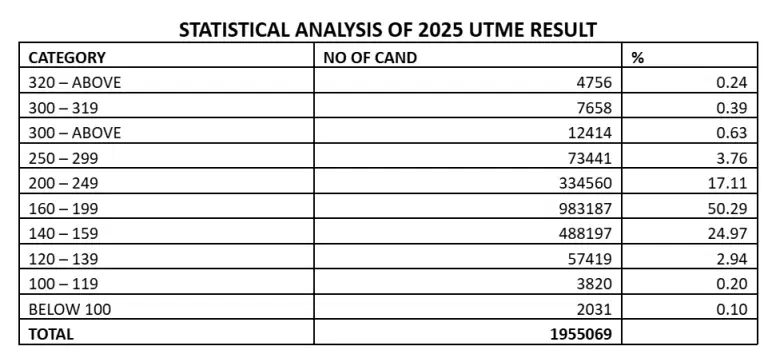The Joint Admissions and Matriculation Board (JAMB) has released the official performance statistics for the just concluded 2025 Unified Tertiary Matriculation Examination (UTME), revealing a wide performance gap among the over 1.5 million candidates who sat for the exam across Nigeria.
According to data obtained from the examination body, only 4,756 candidates scored 320 and above, placing them among the top-performing students in the country.
READ ALSO: JAMB 2025: UTME begins today with over 2M candidates
A total of 7,658 students fell within the 300–319 score range, bringing the number of candidates who scored 300 and above to 12,414—less than 1% of the total number of examinees.

The figures further show that 73,441 students scored between 250 and 299, while a significantly larger group of 334,560 students recorded scores within the 200–249 range.
These two brackets make up a considerable portion of the students who may be considered for admission into top-tier universities depending on departmental cut-off marks.
However, the bulk of the candidates scored below 200, with 983,187 students obtaining scores between 160 and 199, a range generally accepted by polytechnics and some universities for less competitive programs.
Breakingng.com reports that in the lower tiers, 488,197 candidates scored between 140 and 159, while 57,419 students fell into the 120–139 category.
Alarmingly, 3,820 candidates scored between 100 and 119, and 2,031 students scored below 100, a figure that may raise concerns about the preparedness of a segment of Nigerian secondary school students.
The 2025 results highlight both academic excellence at the top and widespread challenges in performance at the bottom, underscoring the need for continued investment in educational infrastructure, teacher training, and student support systems.
JAMB is expected to collaborate with tertiary institutions to commence the 2025 admission process soon, using the Central Admissions Processing System (CAPS) while also engaging in the usual policy meeting to determine national minimum cut-off marks.

